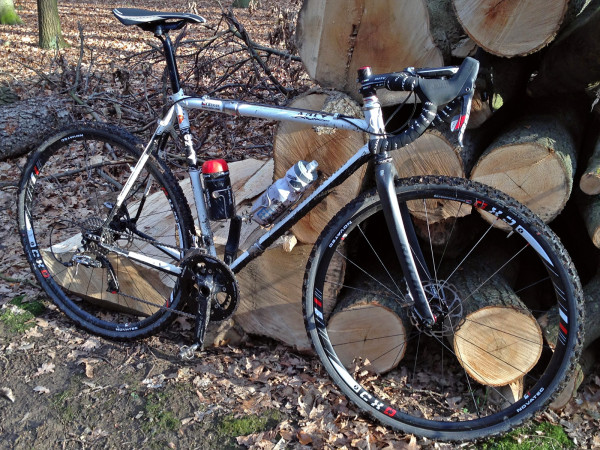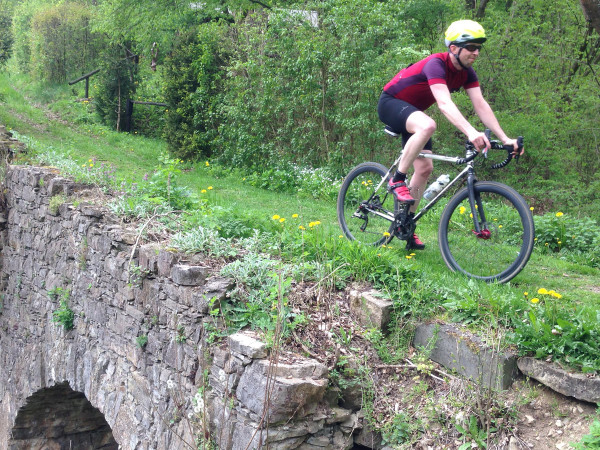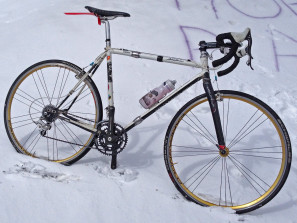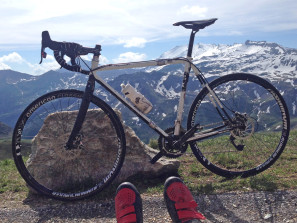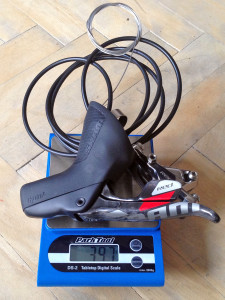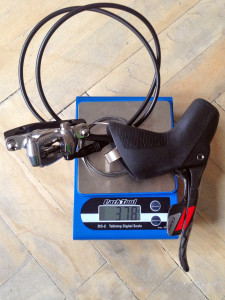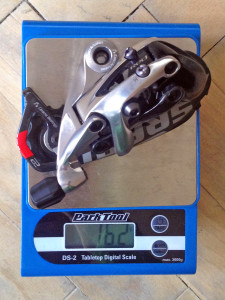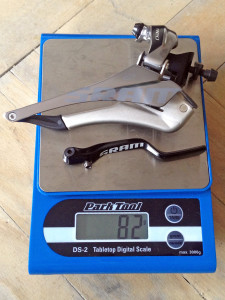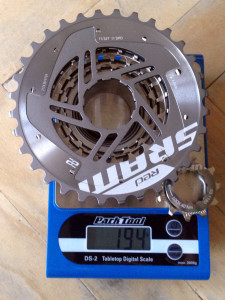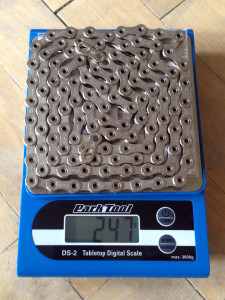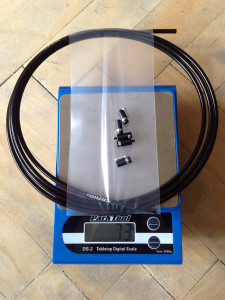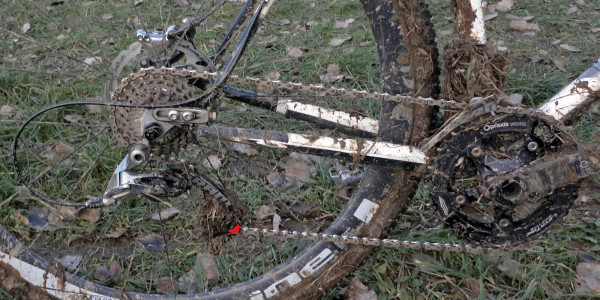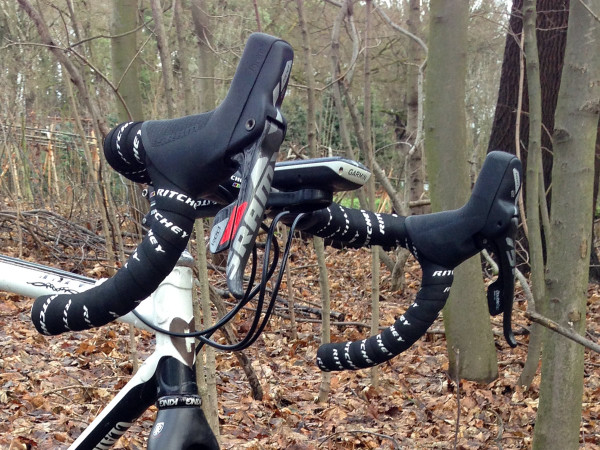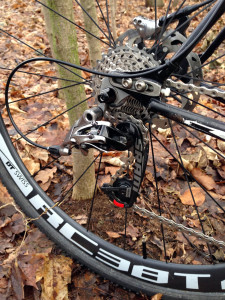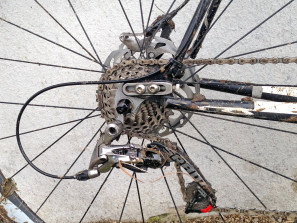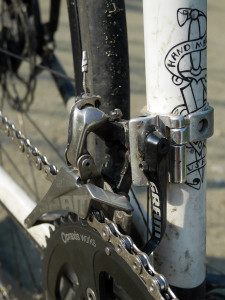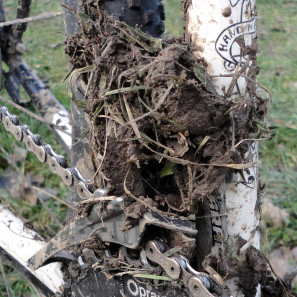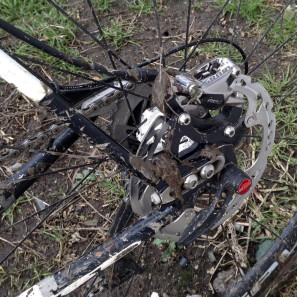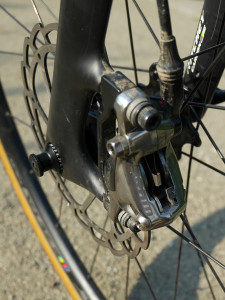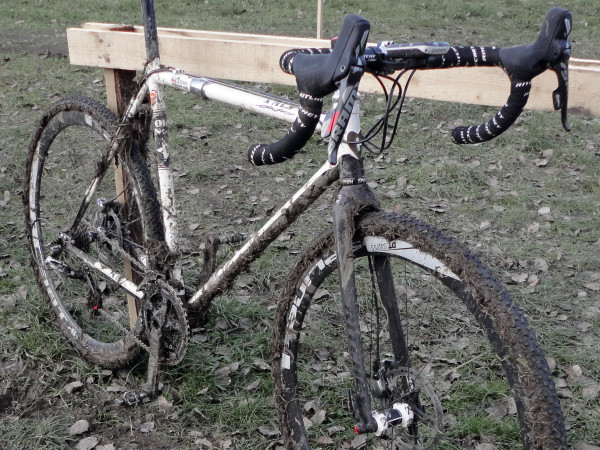Midway through cyclocross season last year we undertook a project to rebuild a lugged steel cyclocross bike, with the idea of upgrading it to disc brakes. Our rationale was both to see how feasible the process would be and to compare the ride of a modernized traditional steel bike with some of the high-end disc brake cyclocross bikes that come through our office. The impetus of the project was probably the availability of the new Ritchey WCS Disc Cross fork with its all-carbon construction and straight 1 1/8″ steerer. Without that fork the bike would probably have not seen this new life (and we will review it in full, next week), but the other big push was to put in a solid amount of time on the updated SRAM Red HydroR groupset after it was overhauled following its rocky start. For a bike that was going to see a lot of types of riding in a mix of conditions the WiFLi configuration of Red22 promised to get us over hill and dale.
Come with us across the break for a full breakdown of the group and our thoughts on how the project bike and SRAM group have fared from last autumn until cross season begins again…
For a bit more of a background on the project, we do a pretty wide range of asphalt, cobbles, dirt, gravel, and singletrack riding plus genuine cross racing that is all right out of the door from our European base in Prague. And it isn’t really uncommon that we might combine bits of each of those riding surfaces on one ride, so versatility is pretty key in a bike. Plus with a decent amount of traveling, it’s always nice to be able to quickly break a bike down whether to pack it into trains, planes, or automobiles. All of that is to preface why this lugged steel cyclocross bike with S&S couplers, custom made for me by now defunct Clark Custom Cycles, has not only gotten a lot of ride time, but deserved an upgrade.
A SRAM Red hydraulic disc brake was teased as early as winter 2012/13 getting in some cross racing action, and was available to consumers in 2013 before being recalled at the end of that year due to its failed seals. With the redesigned system ready last summer we wanted to give the group another shot. We’ve spent time on the hydraulic rim brake version of Red and both the Force CX1 and Rival 22 groups with disc brakes, but it is hard to discount the lure of lightweight and performance from the top Red group.
So a WiFLi setup was put on the project bike with both 11-28 and 11-32 PowerDome cassettes and compact 50/34 (and later semi-compact 52/36) gearing for the off-season and cross 46/36 for proper racing. From mid-November 2014 through February 2015 the groupset saw mud, snow and ice, and more mud as it was put through the ringer at around ten cyclocross races, and in between spent its downtime riding local dirt roads and trails for training. Then as the weather finally warmed a bit the project bike went back into multi-surface road mode to start spring training. And now over the summer and early autumn it has been taken on a few climbing trips to the Austrian and Italian Alps, when it wasn’t exploring Czech backroads.
Tech Details
We’ve detailed the specs on the SRAM Red group in the past when it was first introduced, and even the update last summer, so this time we’ll spend more time with our longer term thoughts. In any case, the levers pre-bled with complete calipers weighed in at 397g for the left and 378g for the right. If you add to that the 112g we’ve weighed a new 160mm centerline rotor, it’s actually about 40g heavier than what SRAM claims per side.
The Red WiFLi rear derailleur is unique not just in a longer cage, but it also gets a slightly longer upper arm to be able to reach all the way across the 11-32 cassette. Our WiFLi derailleur weighs just 162g. The excellent, but finicky YAW front derailleur came in at 82g including the integrated chain catcher. Added together the weight is right on the nose to SRAM’s claims.
Closing out the drivetrain, we paired the WiFLi derailleur with both 11-28 and 11-32 PowerDome cassettes. This being the larger, heavier of the two is still just 194g, while the 11-28 was 165g. The 114 link chain weighed 247g with its PowerLock removable link. The shift housing and ferrules we needed for the build added another 73g.
Review: Racing and Riding
Setup of the Red HydroR drivetrain was mostly painless. The rear derailleur didn’t need anything special, and out of the box the YAW front derailleur has two lines on it to align with the chainrings and then adjust the limit screws. The tall levers and thin transition meant an easy setup to get a comfortable perch on the bars. A quick resize of the the hydraulic lines and top-off rebleed went smoothly with SRAM’s bleed kit. The bleed ports are easy enough to get to by simply rolling back the hoods, and the shape of the lever made it simple to wrap a clean shop towel around the lever to keep fluid from going anywhere. One bleed has lasted the better part of a year with no noticeable deterioration of braking performance.
In the course of a cyclocross racing season the group has spent a lot of harsh weekends in thick mud and been pressure washed a half dozen times. We try to not hit bearings head-on with high pressure water, since we don’t like replacing bearings, but combined with some regular light lubing, the derailleur pulleys still spin smoothly and shifting is as good as ever.
The tall hoods of the SRAM HydroR groups are certainly a divisive topic. Indeed, I was a bit skeptical of the look form the start, but they have grown on me. That is most probably because of the upside of riding trail and racing muddy cross with the big horns on the bike – you really don’t have to hold on. Before updating this bike, I had spent most of my time on smaller Campagnolo hoods which fit nicely in my hands. I hadn’t liked the more bulbous Shimano hoods at the time, but now spending a lot of time riding the HydroR levers off-road I dread switching back to something smaller. The shape is narrow enough for comfort, but with muddy gloves (or hands) or rough terrain, I am able to just loosely place my hands on the hoods and they stay firmly hooked in between thumb and forefinger. It is much like riding in the drops on technical descents where you can loosely hold on without a deathgrip and without fear of your hands bouncing away. So in the end the tall shape has been excellent for adding a secure hand position for the really rough stuff.
The bike has been dropped in the mud plenty of times over the last year, and the shifters seem to be pretty resistant to mud infiltration. The shape of the hood does a good job on protecting the mechanical internals, so we haven’t needed to clean them out even in some messy conditions. The levers have also had a few friendly taps to trees and other fixed objects on course and riding through the woods. No major dramatic crashes or anything, but they have certainly held up to regular wear and tear (even for cross) and plenty of time being unceremoniously laid on the ground without looking any worse for it.
The Red WiFLi rear derailleur has been a solid thankless workhorse. It’s seen mud, grass, and grit, but still shifts well with smooth pulleys, and no noticeable pivot flex. It even saw a big enough impact that the hanger needed to be replaced, and only got a tiny scratch out of the deal that wasn’t even big enough to be able to photograph.
The 11-32 WiFLi gearing was very welcome for climbing mountains in the Alps (and a brief stint with a single chainring), especially on steep gravel climbs and after switching to a 52/36, but the jumps from one gear to the next were apparent. After spending a bit more time this year focusing on cadence, the bigger steps in gearing were a bit frustrating when we weren’t riding technical terrain. We found the 11-28 gearing to be much better suited for racing with its tighter spacing. If it is possible to optimize your chainrings for a certain course (like you might do more often with a 1x setup) there is a big benefit to using smaller range cassettes. The tighter cog spacing results in noticeably quicker shifts and the ability to maintain a smooth and consistent cadence is especially important when you are racing head-to-head with someone else and they are setting the pace.
While the YAW front derailleur was easy to set up out of the box, it became a bit more difficult to deal with as we swapped back and forth for different chainrings. Of course, optimal front shifting (which the YAW Red derailleur does excellently) needs the derailleur to be close to the bigger chainring, so each time we changed from a 46/36 to 50/34 to 52/36 we had to move the derailleur. Once the limit screws had been moved from their factory position the alignment marks on the derailleur’s cage were more of a guide than a rule. We reset the derailleur almost lined-up, but then tried to micro-adjust it without disconnecting its cable and just ended up frustrating ourselves (yes, more than one of us played with it). In the end it was easiest for me to just completely disconnect everything and start from scratch, and when I had to make a tiny adjustment, it meant starting over again. The parting wisdom is to think about what rings you will use, and when it’s time for a swap be prepared for some time fine-tuning. Because when it is set up well the shifting is fast, accurate, reliable and completely silent, something that couldn’t be said about SRAM front derailleurs a couple of years ago.
The Red front derailleur integrates a chain catcher into its mounting bolt. It’s not really designed for the rigors of cyclocross, but still we had no dropped chains or missed shifts with it so are content that it will do its job under all but the most extreme circumstances. Not an exclusive fault to SRAM (Shimano’s new derailleurs are actually much worse) but front derailleurs really love to collect grass and mud. I got the feeling at times that this derailleur was trying to build some primitive dwelling for itself. But even piled high on top with grass and mud, it didn’t pack up inside the linkage or behind it so shifting never suffered. And once cleaned up and lubed again, it has continued to shift without fault.
The HydroR brakes have themselves been the standout of an otherwise very good groupset. The updated brake design offers excellent modulation and respectable power with little input effort at the lever. The brakes are not the strongest, most powerful option out there, but for cyclocross the lighter control and even modulation has been excellent in loose conditions. While some competitors have brakes that feel very On-Off (something I prefer on the mountain bike), the HydroR levers offer a more linear feel with plenty of power on tap.
We went for 160mm rotors on this build primarily to allow easier swaps back-and-forth testing wheels and tires (tubulars especially), but probably made the right call any way as the SRAM Centerline rotors just don’t feel as powerful as their Japanese competitor’s. The project bike has probably had ten wheelsets tried on it in the last year and the best paring has probably been with Shimano rotors that were on Centerlock wheels on test. Also for no discernible reason, the SRAM Centerline rotors seem to squeal a bit more as well.
Our Red brakes come with hardware for 140mm rotors (even when we ordered the bigger rotors as well), so we needed to swap out for some adapters we had on hand from a competitor. This made one of our pro-mechanic friends want to cry, but also brought the issue where SRAM uses Torx heads for their brake mounting while most everyone else sticks with hexes. The included Organic Pads have been powerful and long-lasting, with around 2000km of riding in them, a bit less than half of that in real cross conditions.
Overall the SRAM Red drivetrain has been everything we could have asked for. With the YAW front derailleur, I personally don’t see a need to get rid of gearing range just for the simplicity of a 1x setup, at least in mixed-surface and varied terrain riding. Sure a CX1 setup will get rid of some weight and that grass hut on the front derailleur, but those big gearing steps are less than ideal for racing if you aren’t the one on the front.
Add in that the braking seems exceptionally well matched to cyclocross racing, where a bit more modulation is key to finding that balance between power and traction. We’ve done long descents in the Alps (even one pulling a kid in a Chariot trailer) and the brakes have kept up there as well, with no overheating or loss of power. I can’t say that 140mm Centerline rotors would be up to riding in the mountains, or would have the amount of power that I would personally want on the trail, but paired with 160mm rotors the Red HydroR brakes are excellent performers when searching for narrow tire traction in loose and sloppy conditions.
